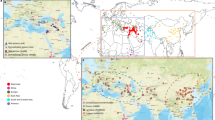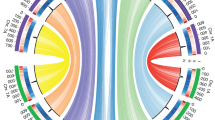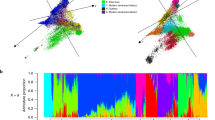Abstract
For more than 10,000 years, the selection of plant and animal traits that are better tailored for human use has shaped the development of civilizations. During this period, bread wheat (Triticum aestivum) emerged as one of the world’s most important crops. We use exome sequencing of a worldwide panel of almost 500 genotypes selected from across the geographical range of the wheat species complex to explore how 10,000 years of hybridization, selection, adaptation and plant breeding has shaped the genetic makeup of modern bread wheats. We observe considerable genetic variation at the genic, chromosomal and subgenomic levels, and use this information to decipher the likely origins of modern day wheats, the consequences of range expansion and the allelic variants selected since its domestication. Our data support a reconciled model of wheat evolution and provide novel avenues for future breeding improvement.
This is a preview of subscription content, access via your institution
Access options
Access Nature and 54 other Nature Portfolio journals
Get Nature+, our best-value online-access subscription
$29.99 / 30 days
cancel any time
Subscribe to this journal
Receive 12 print issues and online access
$209.00 per year
only $17.42 per issue
Buy this article
- Purchase on Springer Link
- Instant access to full article PDF
Prices may be subject to local taxes which are calculated during checkout




Similar content being viewed by others
Data Availability
All data analyzed and generated during this study are included in this published article and its supplementary information files (6 tables and 13 figures) and are available online at https://urgi.versailles.inra.fr/download/iwgsc/IWGSC_RefSeq_Annotations/v1.0/iwgsc_refseqv1.0_Whealbi_GWAS.zip (the catalog of imputed and non-imputed variants as a vcf file and passport information for the 487 genotypes as an .xls file). The Whealbi SNP data are open access and can be viewed in the IWGSC reference genome browser54 at https://urgi.versailles.inra.fr/jbrowseiwgsc/gmod_jbrowse/?data=myData%2FIWGSC_RefSeq_v1.0. The sequence data are available at NCBI under the accession number PRJNA524104.
References
Feldman, M. & Levy, A. A. Genome evolution due to allopolyploidization in wheat. Genetics 192, 763–774 (2012).
Tanno, K. & Willcox, G. How fast was wild wheat domesticated? Science 311, 1886 (2006).
Brown, T. A., Jones, M. K., Powell, W. & Allaby, R. G. The complex origins of domesticated crops in the Fertile Crescent. Trends Ecol. Evol. 24, 103–109 (2009).
Bocquet-Appel, J. P., Naji, S., Vander Linden, M. & Kozlowski, J. K. Detection of diffusion and contact zones of early farming in Europe from the space-time distribution of 14C dates. J. Archaeol. Sci. 36, 807–820 (2009).
Szécsényi-Nagy, A., Brandt, G., Keerl, V., Jakucs, J. & Haak, W. Tracing the genetic origin of Europe’s first farmers reveals insights into their social organization. Proc. R. Soc. B. 282, 20150339 (2015).
Damania, A. B. et al. (eds) The Origin of Agriculture and Crop Domestication (ICARDA, 1997).
Warr, A. et al. Exome sequencing: current and future perspectives. G3 (Bethesda) 5, 1543–1550 (2015).
The International Wheat Genome Sequencing Consortium (IWGSC) et al. Shifting the limits in wheat research and breeding using a fully annotated reference genome. Science 361, eaar7191 (2018).
Matsuoka, Y. Evolution of polyploid triticum wheats under cultivation: the role of domestication, natural hybridization and allopolyploid speciation in their diversification. Plant Cell Physiol. 52, 750–764 (2011).
Gao, L., Zhao, G., Huang, D. & Jia, J. Candidate loci involved in domestication and improvement detected by a published 90K wheat SNP array. Sci. Rep. 7, 44530 (2017).
Wright, S. I. et al. The effects of artificial selection on the maize genome. Science 308, 1310–1314 (2005).
Luu, K., Bazin, E. & Blum, M. G. pcadapt: an R package to perform genome scans for selection based on principal component analysis. Mol. Ecol. Resour. 17, 67–77 (2017).
Jordan, K. W., Wang, S., Lun, Y., Gardiner, L. J., MacLachlan, R. A haplotype map of allohexaploid wheat reveals distinct patterns of selection on homoeologous genomes. Genome Biol. 16, 48 (2015).
Cavanagh, C. R. et al. Genome-wide comparative diversity uncovers multiple targets of selection for improvement in hexaploid wheat landraces and cultivars. Proc. Natl Acad. Sci. USA 110, 8057–8062 (2013).
Joukhadar, R., Daetwyler, H. D., Bansal, U. K., Gendall, A. R. & Hayden, M. J. Genetic diversity, population structure and ancestral origin of Australian wheat. Front. Plant Sci. 8, 2115 (2017).
Nielsen, N. H., Backes, G., Stougaard, J., Andersen, S. U. & Jahoor, A. Genetic diversity and population structure analysis of European hexaploid bread wheat (Triticum aestivum L.) varieties. PLoS ONE 9, e94000 (2014).
Devos, K. M., Dubcovsky, J., Dvorak, J., Chinoy, C. N. & Gale, M. D. Structural evolution of wheat chromosomes 4A, 5A, and 7B and its impact on recombination. Theor. Appl. Genet. 91, 282–288 (1995).
Nadolska-Orczyk, A., Rajchel, I. K., Orczyk, W. & Gasparis, S. Major genes determining yield-related traits in wheat and barley. Theor. Appl. Genet. 130, 1081–1098 (2017).
Gardiner, L. J. et al. Hidden variation in polyploid wheat drives local adaptation. Genome Res. 28, 1319–1332 (2018).
Lischer, H. E., Excoffier, L. & Heckel, G. Ignoring heterozygous sites biases phylogenomic estimates of divergence times: implications for the evolutionary history of microtus voles. Mol. Biol. Evol. 31, 817–831 (2014).
Nguyen, L. T., Schmidt, H. A., Von Haeseler, A. & Minh, B. Q. IQ-TREE: a fast and effective stochastic algorithm for estimating maximum-likelihood phylogenies. Mol. Biol. Evol. 32, 268–274 (2015).
Martin, S. H., Davey, J. W., Jiggins, C. D. Evaluating the use of ABBA-BABA statistics to locate introgressed loci. Mol. Biol. Evol. 32, 244–257 (2015).
Ben-David, R. et al. Dissection of powdery mildew resistance uncovers different resistance types in the T. turgidum L. gene pool. in 11th Int. Wheat Genetics Symposium (Sydney University Press, 2008).
El Baidouri, M., Murat, F., Veyssiere, M., Molinier, M. & Flores, R. Reconciling the evolutionary origin of bread wheat (Triticum aestivum). New Phytol. 213, 1477–1486 (2017).
Balint, A. F., Kovacs, G. & Sutka, J. Origin and taxonomy of wheat in the light of recent research. Acta Agronomica Hungarica 48, 301–313 (2000).
Nesbitt, M. & Samuel, D. From staple crop to extinction: the archaeology and history of the hulled wheats. in Proc. 1st International Workshop on Hulled Wheats (International Plant Genetic Resources Institute, 1996).
Civáň, P., Ivaničová, Z. & Brown, T. A. Reticulated origin of domesticated emmer wheat supports a dynamic model for the emergence of agriculture in the fertile crescent. PLoS ONE 8, e81955 (2013).
Luo, M. C., Yang, Z. L., You, F. M., Kawahara, T. & Waines, J. G. The structure of wild and domesticated emmer wheat populations, gene flow between them, and the site of emmer domestication. Theor. Appl. Genet. 114, 947–959 (2007).
Matsuoka, Y. & Nasuda, S. Durum wheat as a candidate for the unknown female progenitor of bread wheat: an empirical study with a highly fertile F1 hybrid with Aegilops tauschii Coss. Theor Appl Genet. 109, 1710–1717 (2004). Epub 2004 Sep 22.
Wang, J., Luo, M. C., Chen, Z., You, F. M. & Wei, Y. Aegilops tauschii single nucleotide polymorphisms shed light on the origins of wheat D-genome genetic diversity and pinpoint the geographic origin of hexaploid wheat. New Phytol. 198, 925–937 (2013).
Minh, B. Q., Nguyen, M. A. & von Haeseler, A. Ultrafast approximation for phylogenetic bootstrap. Mol. Biol. Evol. 30, 1188–1195 (2013).
Revell, L. J. phytools: an R package for phylogenetic comparative biology (and other things). Methods Ecol. Evol. 3, 217–223 (2012).
Kucera, M. et al. AutoAnnotate: a Cytoscape app for summarizing networks with semantic annotations. F1000 Res. 5, 1717 (2016).
Korneliussen, ThorfinnSand, Albrechtsen, Anders & Nielsen, Rasmus ANGSD: analysis of next generation sequencing data. BMC Bioinformatics 15, 356 (2014).
Durand, E. Y., Patterson, N., Reich, D. & Slatkin, M. Testing for ancient admixture between closely related populations. Mol. Biol. Evol. 28, 2239–2252 (2011).
Lê, S. et al. FactoMineR: an R package for multivariate analysis. J. Stat. Soft. 25, 1–18 (2008).
R. Core Team. R: a Language and Environment for Statistical Computing (R Foundation for Statistical Computing, 2014).
Chipman, H. & Tibshirani, R. Hybrid hierarchical clustering with applications to microarray data. Biostatistics 7, 286–301 (2006).
Schmidtlein, S., Tichy, L., Hannes, F. & Ulrike, F. A brute-force approach to vegetation classification. J. Veg. Sci. 21, 1162–1171 (2010).
Witten, D. M. & Tibshirani, R. A framework for feature selection in clustering. J. Am. Stat. Assoc. 105, 713–726 (2010).
Galili, T. dendextend: an R package for visualizing, adjusting and comparing trees of hierarchical clustering. Bioinformatics 31, 3718–3720 (2015).
Rodríguez-Álvarez, M. X., Boer, M. P., van Eeuwijk, F. A. & Eilers, P. H. Correcting for spatial heterogeneity in plant breeding experiments with P-splines. Spatial Stat. 23, 52–71 (2017).
Gu, Z., Gu, L., Eils, R., Schlesner, M. & Brors, B. irclize implements and enhances circular visualization in R. Bioinformatics 30, 2811–2812 (2014).
Rincent, R. et al. Recovering power in association mapping panels with variable levels of linkage disequilibrium. Genetics 197, 375–387 (2014).
Astle, W. & Balding, D. J. Population structure and cryptic relatedness in genetic association studies. Stat. Sci. 24, 451–471 (2009).
Wimmer, V., Albrecht, T., Auinger, H. J. & Schön, C. C. synbreed: a framework for the analysis of genomic prediction data using R. Bioinformatics 28, 2086–2087 (2012).
Millet, E. J. et al. Genome-wide analysis of yield in Europe: allelic effects vary with drought and heat scenarios. Plant Physiol. 172, 749–764 (2016).
Thoen, M. P. et al. Genetic architecture of plant stress resistance: multi‐trait genome‐wide association mapping. New Phytologist 213, 1346–1362 (2017).
Patterson, N., Price, A. L. & Reich, D. D, Population Structure and Eigenanalysis. PLoS Genet. 2, e190 (2006).
Welham, S. J. & Thompson, R. Likelihood Ratio Tests for Fixed Model Terms using Residual Maximum Likelihood. J. R. Statist. Soc. 59, 701–714 (1997).
Boer, M. P. et al. A mixed-model quantitative trait loci (QTL) analysis for multiple-environment trial data using environmental covariables for QTL-by-environment interactions, with an example in maize. Genetics. 177, 1801–1813 (2007).
Devlin, B., Roeder, K. & Genomic, K. Control for association studies. Biometrics 55, 997–1004 (1999).
Li, J. & Ji, L. Adjusting multiple testing in multilocus analyses using the eigenvalues of a correlation matrix. Heredity 95, 221–227 (2005).
Alaux, M. et al. Linking the International Wheat Genome Sequencing Consortium bread wheat reference genome sequence to wheat genetic and phenomic data. Genome Biol. 19, 111 (2018).
Acknowledgements
The authors wish to thank the INRA Biological Resources Center on small grain cereals (https://www6.ara.inra.fr/umr1095_eng/Teams/Research/Biological-Resources-Centre) for providing seeds and passport data, and for establishing a wheat biorepository. The authors thank the Federal ex situ Genbank Gatersleben, Germany (IPK), the N. I. Vavilov All-Russian Research Institute of Plant Industry, Russia (VIR), Centre for Genetic Resources, WUR, Netherlands (CGN), Kyoto University, National Bioresource Project, Japan (NBRP), the Australian Winter Cereal Collection Tamworth, Australia (AWCC), the National Plant Germplasm System, USA (USDA-ARS), the International Center for Agriculture Research in the Dry Areas (ICARDA), the Max Planck Institute for Plant Breeding Research Cologne, Germany (MPIPZ), Germplasm Resource Unit at the John Innes Centre UK (JIC) and the Wheat and Barley Legacy for Breeding Improvement (WHEALBI) consortium for providing plant material and passport data. The research leading to these results has received funding from the European Community’s Seventh Framework Programme (FP7/ 2007–2013) under grant agreement FP7- 613556, Whealbi project (http://www.whealbi.eu/project/). R.W. and J.R. also acknowledge support from the Scottish Government Research Program and R.W. from the University of Dundee. H.O. acknowledges support from Çukurova University (FUA-2016–6033). K.F.X.M. acknowledges support from the German Federal Ministry of Food and Agriculture (2819103915) and the DFG (SFB924). T.L. acknowledges supports from the Agence Nationale pour la Recherche (BirdIslandGenomic project 14-CE02-0002), European Research Council (TREEPEACE project, grant agreement 339728) and the bioinformatics platform from Toulouse Midi-Pyrénées (Bioinfo Genotoul) for providing computing and storage resources. J.S. acknowledges support from the Région Auvergne-Rhône-Alpes and FEDER Fonds Européens de Développement Régional (23000816 SRESRI 2015), the CPER contrat de plan État-région (23000892 SYMBIOSE 2016) and AgreenSkills fellowship (applicant ID 4146).
Author information
Authors and Affiliations
Consortia
Contributions
F.B., B.K. and N.S. carried out panel constitution and distribution. S.D., J.R. and R.W. carried out exome sequencing. D.W., M.Se., M.Sp. and G.H. carried out variant (SNP and indel) calling. C.P., D.A., N.G., M.Se., D.L. and W.D. carried out variant analysis. D.L., W.D., M.Se., C.P., N.G. and G.H. carried out phylogenetic analyis. T.L., C.P. and D.A. carried out diversity analysis and selection footprints. A.T., D.B.K., C.P., H.O., M.M., F.E. and L.C. carried out field experiments and GWAS. B.K., J.R., K.F.X.M., R.W., N.S., L.C., G.H., G.C. and J.S. conceived and supervised the study and prepared the article.
Corresponding author
Ethics declarations
Competing interests
The authors declare no competing interests.
Additional information
Publisher’s note: Springer Nature remains neutral with regard to jurisdictional claims in published maps and institutional affiliations.
Supplementary information
Supplementary Information
Supplementary Tables 1–7 and Supplementary Figures 1–13
Rights and permissions
About this article
Cite this article
Pont, C., Leroy, T., Seidel, M. et al. Tracing the ancestry of modern bread wheats. Nat Genet 51, 905–911 (2019). https://doi.org/10.1038/s41588-019-0393-z
Received:
Accepted:
Published:
Issue Date:
DOI: https://doi.org/10.1038/s41588-019-0393-z
This article is cited by
-
A platform for whole-genome speed introgression from Aegilops tauschii to wheat for breeding future crops
Nature Protocols (2024)
-
Genome-wide association studies reveal novel loci for grain size in two-rowed barley (Hordeum vulgare L.)
Theoretical and Applied Genetics (2024)
-
Genetic diversity and population structure of modern wheat (Triticum aestivum L.) cultivars in Henan Province of China based on SNP markers
BMC Plant Biology (2023)
-
Transposable element-initiated enhancer-like elements generate the subgenome-biased spike specificity of polyploid wheat
Nature Communications (2023)
-
Allelic variation of TaWD40-4B.1 contributes to drought tolerance by modulating catalase activity in wheat
Nature Communications (2023)



